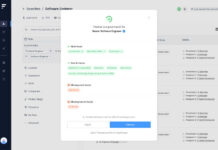
In this guest column Ian Cook, vice president of people solutions at Visier, discusses why AI’s success depends on people and technology working hand-in-hand.
We live in an age that will be looked back on as one of the single most transformative eras in human history. Similar to the Industrial Age and the Information Age, the AI Age will bring about significant shifts in how we live and work.
Automation and “thoughtful” machines are quickly replacing tasks and jobs once viewed as requiring human hands. These momentous changes raise huge questions and challenges for organizations, particularly when it comes to looking at their workforces. The curiosity of AI is that it not only threatens to replace human roles but that it can, if used correctly, also be used to empower the people in one’s organization.
As organizations begin to implement #AI, a human element must be in place to ensure that the workforce feels valued and secure. #HR #HRTech @Visier Share on XFear of AI replacing job roles is becoming an increasing concern in business. A recent PwC survey found that 37 percent of respondents were concerned that AI and automation are putting their jobs at risk.
The same survey asked respondents what they felt were the most important capabilities for their organizations to have now and in the future. “Priorities such as creating trust and transparency, nurturing human skills, valuing human-centric working and wellbeing dominate the list of capabilities that our respondents believe are key,” the report said.
Looking at these responses, it’s clear that as organizations begin to implement AI, a human element needs to be in place to ensure that the workforce feels valued and secure. But just how can this be applied? Let’s look at a couple of areas where AI can make work more human.
AI & Skills Development
What is abundantly clear with the AI Age is that organizations need to invest in retraining their employees to assume different roles. In fact, a McKinsey report suggests the only way the AI transformation will succeed is for people and technology to work hand-in-hand.
Interestingly enough, AI (predictive analytics, specifically) can already support this shift in several ways: First, the technology can identify employees who would benefit most from being re-skilled, thereby increasing their job satisfaction and overall contribution to the organization. Second, predictive analytics can suggest what the overall impact of specific reskilling programs will be on the workforce.
In the past, most workers had a single career in their lifetime. As automation accelerates, workers will likely require a new portfolio of skills about once every decade. Developing and deploying useful training takes time. Rather than simply throwing money at it, businesses should investigate the cause of every notable success and failure. By utilizing AI to measure inputs, track outcomes, model different programs, organizations can learn “what works” and begin to develop best practices.
AI & Happiness

Improving employee happiness through AI seems like a pipe dream, but in some cases it’s already started to show promising results. Take for example Humu, a small startup launched by former employees of Google. The company uses AI to dig through a substantial number of employee survey results and identifies one or two individual behavioral changes that are likely to have the biggest impact on elevating a workforce’s happiness and productivity. It then uses emails and text messages to “nudge” specific employees into small actions that help advance larger organizational goals.
That’s just one example of how AI can boost organizational results. Another regards the ways in which predictive analytics can increase the speed and efficiency of identifying underlying discontent in a company’s workforce.
Take, for another example, Worklytics, which analyzes real-time behavioral data captured in productivity tools like email, Office 365 or Github to provide an overview of how teams and departments invest their time at work. AI captures and analyzes data on communication and collaboration across all tools to determine bottlenecks, map out knowledge centers and better understand the real organizational structure. It also benefits employees by identifying gaps in connections, like not enough time with direct reports, too many overlapping meetings or even meetings with global teams that could be cutting into personal and family time.
There are a wealth of areas that can be supported and improved by AI. Streamlined conflict resolution, 24-hour assistance and support and increased engagement between remote and on-site employees open a world of possibilities. Individually, each of these examples may have limited impact on employee happiness. However, collectively they paint a picture of a more satisfied and engaged workforce, thanks to a thoughtfully structured organization that puts people first.
Using AI with a smart, human-centric approach will help organizations—and more importantly the people within those organizations—become better at their jobs, learn valuable skills and feel happier and more satisfied with their role.
Ian Cook heads the workforce domain for Visier, which develops cloud-based applications that enable HR professionals to answer workforce strategy questions.
Sign up for our newsletter here.
Image: iStock
Guest columns are sponsored content and adhere to the HCM Technology Report’s editorial guidelines. They do not necessarily reflect the opinions of the editors.















